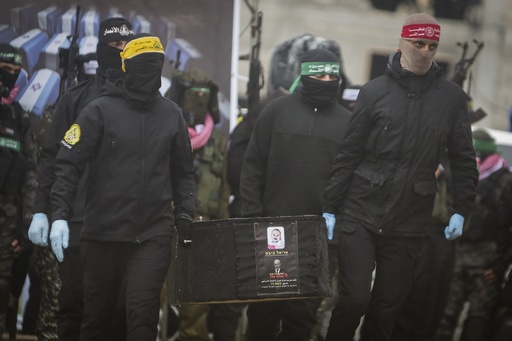TEL AVIV, Israel — On Friday, the Israeli military announced it had confirmed the identification of two young hostages who were killed, but it also revealed that the body released by Hamas, which they claimed was the boys’ mother, was not actually Shiri Bibas. This development adds another layer of complexity and tragedy to the Bibas family’s ongoing ordeal, thrusting them into the spotlight as symbols of the wider crisis faced by Israeli hostages held by Hamas. The situation raises serious doubts about the future of the currently fragile ceasefire.
“This is an egregious violation by the terrorist organization Hamas,” the military stated in a press release. Since the ceasefire began a month prior, Hamas has been exchanging living hostages for hundreds of Palestinian prisoners. The release on Thursday marked the first time the group returned the remains of deceased hostages.
Earlier that day, Hamas handed over four bodies to the Red Cross, leading to an immediate confirmation from Israeli officials that one of them belonged to 83-year-old Oded Lifshitz, who was kidnapped during the initial Hamas attack on October 7, 2023. Hamas had claimed that the other remains were those of Shiri Bibas and her two sons, Ariel and Kfir; however, Israeli authorities later indicated that, while the boys had been identified, the other body did not belong to their mother and did not match any other missing hostages.
“This remains is unidentified and anonymous,” the military stressed. “We demand that Hamas return Shiri home along with all our hostages.” The Israeli forces have also informed Shiri’s family of the situation, including her husband, Yarden Bibas, who was released earlier in the month as part of the ceasefire terms.
Hamas has asserted that the four hostages they returned on Thursday died in Israeli airstrikes; however, Israeli testing claims indicated that Lifshitz and the boys were victims of their captors. As of now, Hamas has not responded to Israel’s announcement regarding the misleading identification of the body.
A U.S. official expressed serious concerns regarding Hamas’ actions. Adam Boehler, the U.S. envoy for hostages, described Hamas’ reported release of the wrong remains as “horrific” and a “clear violation” of the ceasefire that has paused the fighting in Gaza. He added, “If I were them, I’d release everybody or face total destruction.”
The ongoing uncertainty casts doubt on whether the next planned host swap, anticipated for Saturday, will proceed as scheduled. The continuation of the truce, which has paused 15 months of conflict, is also in question as the current phase is set to expire in early March. Additional turmoil ensued on Thursday, with explosions affecting three parked buses in central Israel, although no injuries were reported and no one took responsibility. In response, the military indicated it would enhance its presence in the West Bank, which raises the prospects of further conflict in the area.
The return of the remains triggered a nationwide outpouring of grief. Crowds gathered to honor the memory of the deceased as they processed through the streets with flags amidst rainy weather. A solitary vigil took place in Tel Aviv where many mourners recited prayers, held memorials, and remembered the tragic loss, creating a somber atmosphere in contrast to the earlier celebratory receptions of living hostages.
Militants presenting the remains displayed black coffins, surrounded by banners mocking Israeli leadership. Numerous masked individuals watched as the coffins were transferred to Red Cross vehicles before they reached Israeli authorities. Subsequently, military officials conducted a brief funeral for the deceased at the families’ request prior to moving the bodies for forensic analysis.
In Tel Aviv, a double rainbow appeared in the sky as sunset approached, and thousands gathered to commemorate the fallen. Israeli President Isaac Herzog expressed deep condolences, stating, “Our hearts—as those of an entire nation—are shattered. I bow my head and ask for forgiveness—for not protecting you on that dark day.”
Kfir Bibas, the youngest hostage taken at just 9 months old, was abducted alongside his elder brother Ariel, who was 4 years old during the initial attack. Video footage from that day depicted a distressed Shiri holding her boys as they were taken away. Yarden Bibas, the boys’ father, was held separately before his eventual release. The Bibas family had maintained hope, celebrating the boys’ birthdays in anticipation of good news until the identity confirmation came through.
Romina Miasnik, a relative of Shiri Bibas residing in Buenos Aires, shared her anguish, expressing that she hopes her family can symbolize new beginnings and reject hatred moving forward.
Oded Lifshitz had also been taken from Kibbutz Nir Oz alongside his wife Yocheved, who was freed early in the conflict. The Hamas-led attack on October 7 resulted in the abduction of 251 hostages, including numerous children, and was also marked by the deaths of around 1,200 people, primarily civilians.
Currently, while many hostages have been freed or their remains recovered, approximately 66 individuals are still believed to be in captivity, with around half presumed alive. Hamas plans to release six living hostages as part of Saturday’s deals, and four additional bodies are expected to be turned over next week, marking the completion of the first phase of negotiations. Yet, Hamas insists on a lasting ceasefire for any more hostages to be released, citing that they will not proceed without clear commitments from Israel concerning military operations.
The potential for conflict remains in question as Israeli military operations have reportedly led to substantial casualties in Gaza, with reports claiming tens of thousands have died, primarily women and children. Infrastructure in the region has been devastated, leading to the displacement of much of Gaza’s population. In light of these circumstances, the continuation and aftermath of the ceasefire remain delicately balanced amid rising tensions in the region.




